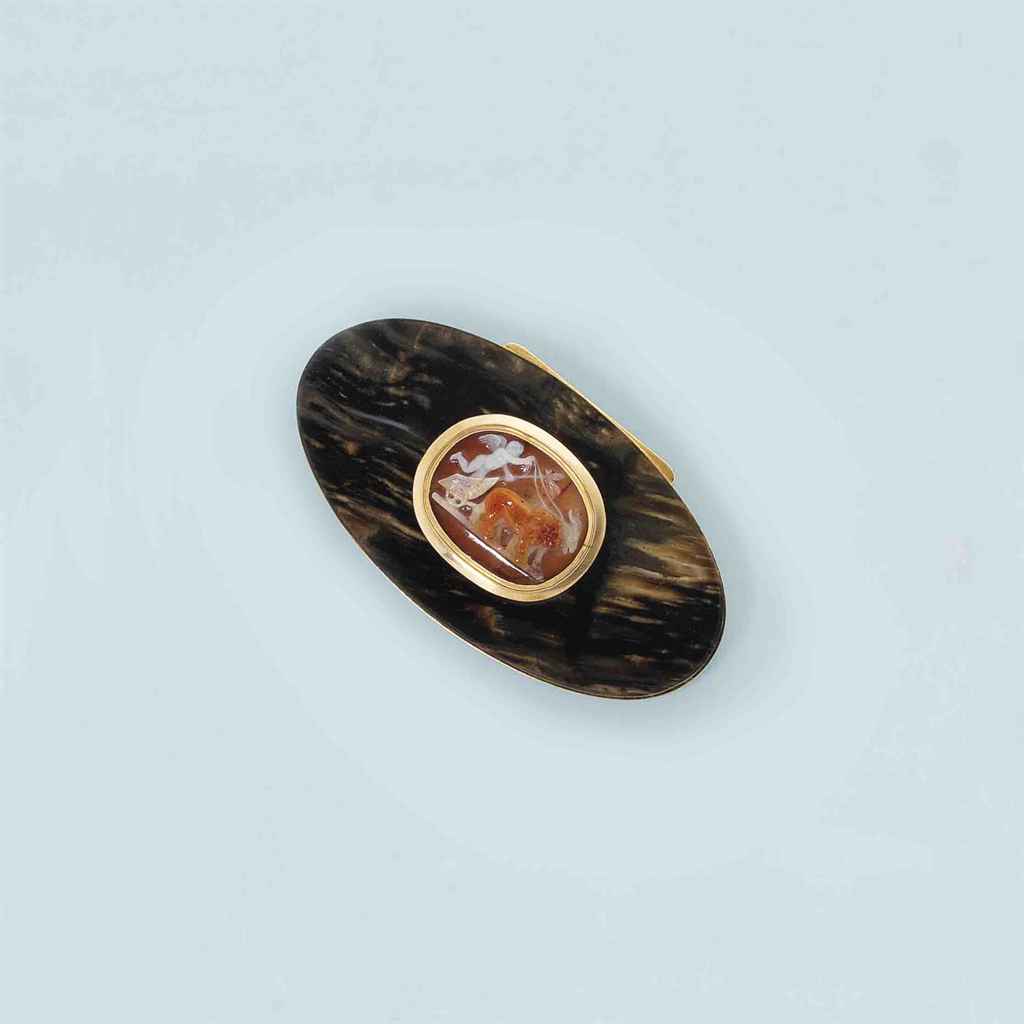A French hardstone cameo brooch, circa 1820s-50s, finely carved in high relief to depict the profile, a dexter, of a classical maiden, possibly Clytia, engraved ‘BASSOT, collet set in a plain yellow precious metal brooch mount, length 49mm. £2000-2500 Condition Report The cameo is finely carved and in good condition; there is a little dirt caught within some of the detail of the curls of hair, but no damage and minimal wear. The plain mount shows some light surface scuffing, the pin is vertically mounted. The mount may be later added. It appears to be gold but remains unmarked and untested. Brooch width 39mm. Footnote In Greek mythology, Clytia (or Roman ‘Clytie’) was a water nymph who harboured an unrequited love for Apollo, the God of the Sun. She sat pining for him, her face always following the sun as it crossed the sky, until eventually she transformed into a flower.(Ovid, Metamorphoses, IV). This cameo may possibly be an interpretation of the Roman marble bust identified (to some debate) as Clytie. This sculpture, purchased in Naples in 1772 by Charles Townley is now in the British Museum (ref: 1805,0703.79). In the late 18th century, the gem engraver Nathaniel Marchant made a famous intaglio of the bust in profile, published in the catalogue of his intaglios in 1792. Jewellery historian Charlotte Gere notes that this was “a widely popular image in the late eighteenth century [and] it is apparent that interest once again focused on the 'Clytie' bust in the mid-nineteenth century, as it was copied by the sculptor H. Delpech and issued as a Parian 'Statuary Porcelain' bust by Copelands for the Art Union in 1855 and was one of the most popular of these sculptural models.”. See: Tait, H. ed, The Art of the Jeweller: A catalogue of the Hull Grundy gift to the British Museum, British Museum Publications, 1984, plate 919 and: Rowan, M, Nineteenth Century Cameos, Antique Collectors Club, 2004, p52. The French jeweller, art collector and author Henri Vever makes reference to a jeweller by the name of Léon Bassot: ‘Artistic Jewelry’ (stet) in his book ‘La Bijouterie Francaise au XIXem Siècle’, a survey of the jewellery produced in Paris from the Empire to the Art Nouveau period, first published in France between 1906-08. See: Vever, Henri, French Jewellery of the Nineteenth Century, translated by Katherine Purcell, Thames & Hudson, 2001, p430. The Almanach du Commerce de Paris, des départements de l’Empire francais, et de principales villes du monde, Volume 12, 1809, also lists a Jeweller/Watch maker named ‘BASSOT ‘ of ‘Rue Saint-Honoré, under the title of ‘Horlogers’.
A French hardstone cameo brooch, circa 1820s-50s, finely carved in high relief to depict the profile, a dexter, of a classical maiden, possibly Clytia, engraved ‘BASSOT, collet set in a plain yellow precious metal brooch mount, length 49mm. £2000-2500 Condition Report The cameo is finely carved and in good condition; there is a little dirt caught within some of the detail of the curls of hair, but no damage and minimal wear. The plain mount shows some light surface scuffing, the pin is vertically mounted. The mount may be later added. It appears to be gold but remains unmarked and untested. Brooch width 39mm. Footnote In Greek mythology, Clytia (or Roman ‘Clytie’) was a water nymph who harboured an unrequited love for Apollo, the God of the Sun. She sat pining for him, her face always following the sun as it crossed the sky, until eventually she transformed into a flower.(Ovid, Metamorphoses, IV). This cameo may possibly be an interpretation of the Roman marble bust identified (to some debate) as Clytie. This sculpture, purchased in Naples in 1772 by Charles Townley is now in the British Museum (ref: 1805,0703.79). In the late 18th century, the gem engraver Nathaniel Marchant made a famous intaglio of the bust in profile, published in the catalogue of his intaglios in 1792. Jewellery historian Charlotte Gere notes that this was “a widely popular image in the late eighteenth century [and] it is apparent that interest once again focused on the 'Clytie' bust in the mid-nineteenth century, as it was copied by the sculptor H. Delpech and issued as a Parian 'Statuary Porcelain' bust by Copelands for the Art Union in 1855 and was one of the most popular of these sculptural models.”. See: Tait, H. ed, The Art of the Jeweller: A catalogue of the Hull Grundy gift to the British Museum, British Museum Publications, 1984, plate 919 and: Rowan, M, Nineteenth Century Cameos, Antique Collectors Club, 2004, p52. The French jeweller, art collector and author Henri Vever makes reference to a jeweller by the name of Léon Bassot: ‘Artistic Jewelry’ (stet) in his book ‘La Bijouterie Francaise au XIXem Siècle’, a survey of the jewellery produced in Paris from the Empire to the Art Nouveau period, first published in France between 1906-08. See: Vever, Henri, French Jewellery of the Nineteenth Century, translated by Katherine Purcell, Thames & Hudson, 2001, p430. The Almanach du Commerce de Paris, des départements de l’Empire francais, et de principales villes du monde, Volume 12, 1809, also lists a Jeweller/Watch maker named ‘BASSOT ‘ of ‘Rue Saint-Honoré, under the title of ‘Horlogers’.














Try LotSearch and its premium features for 7 days - without any costs!
Be notified automatically about new items in upcoming auctions.
Create an alert